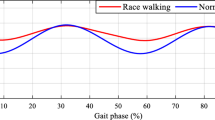Abstract
The mechanical structure and the joint torques configuration are the important parts in the biped robot design. Meanwhile, different walking speed and step length should be chosen to achieve efficient gait according to different need of walking environment. Therefore, this paper investigates the energetic walking gaits using a simple actuated inverted pendulum model. Joint torques and push-off impulse are both added in the model. The walking gaits with different joint torques configuration and with different combination of walking speeds and step lengths are analyzed. The results show that hip velocity direction is changed by the push-off impulse just before the heelstrike, which reduces the energy consumption of each step. The walking gait with minimal energy consumption is the walking pattern only with push-off, the energy cost of which is 1/4 of the walking pattern only with joint torque during the swing phase. The cost of transport (COT) and the push-off impulse of the walking gait is increasing with the increase of walking speed and step length. Using same value of push-off impulse, the walking with long step length and slow speed is more efficient. The paper can provide suggestions for designing advanced legged robot systems with high energy efficiency and various gaits. For example, the consideration of push-off mechanism can be used in the biped robots design.
Similar content being viewed by others
References
S. Kuindersma, R. Deits, M. Fallon, A. Valenzuela, H. Dai, F. Permenter, T. Koolen, P. Marion and R. Tedrake, Optimization-based locomotion planning, estimation, and control design for the Atlas humanoid robot, Autonomous Robots, 40 (3) (2016) 429–455.
DRC-HUBO, http://www.drc-hubo.com/, June (2015).
F. L. Moro, N. G. Tsagarakis and D. G. Caldwell, Efficient human-like walking for the compliant huMANoid COMAN based on Kinematic Motion Primitives (kMPs), IEEE International Conference on Robotics and Automation, Saint Paul, Minnesota, USA (2012).
T. McGeer, Passive dynamic walking, The International Journal of Robotics Research, 9 (1990) 68–82.
S. Collins, A. Ruina, R. Tedrake and M. Wisse, Efficient bipedal robots based on passive dynamic walkers, Science Magazine, 307 (2005) 1082–1085.
A. Ramezani, J. W. Hurst and K. A. Hamed, Performance analysis and feedback control of ATRIAS, a threedimensional bipedal robot, Journal of Dynamic Systems Measurement and Control, Transactions of the ASME, 136 (2) (2013) 021012.
P. A. Bhounsule, J. Cortell, A. Grewal, B. Hendriksen, J. G. D. Karssen, C. Paul and A. Ruina, Low-bandwidth reflexbased control for lower power walking: 65 km on a single battery charge, The International Journal of Robotics Research, 33 (10) (2014) 1305–1321.
A. D. Kuo, Harvesting energy by improving the economy of human walking, Science, 309 (5741) (2005) 1686–1687.
A. D. Kuo, J. M. Donelan and A. Ruina, Energetic consequences of walking like an inverted pendulum: Step-to-step transitions, Exercise and Sport Sciences Reviews, 33 (2) (2005) 88–97.
J. M. Donelan, R. Kram and A. D. Kuo, Simultaneous positive and negative external mechanical work in human walking, Journal of Biomechanics, 35 (2002) 117–124.
J. M. Donelan et al., Mechanical and metabolic requirements for active lateral stabilization in human walking, Journal of Biomechanics, 37 (2004) 827–835.
J. Doke, J. M. Donelan and A. D. Kuo, Mechanics and energetics of swinging the human leg, Journal of Experimental Biology, 208 (2005) 439–445.
M. Srinivasan and A. Ruina, Computer optimization of a minimal biped model discovers walking and running, Nature, 439 (2006) 72–75.
M. Srinivasan and A. Ruina, Idealized walking and running gaits minimize work, Proc. of the royal Society A, 463 (2007) 2429–2446.
S. J. Hasaneini, C. J. B. Macnab, J. E. A. Bertram and H. Leung, The dynamic optimization approach to locomotion dynamics: Human-like gaits from a minimally constrained biped model, Advanced Robotics, 27 (11) (2013) 845–859.
A. D. Kuo, A simple model of bipedal walking predicts the preferred speed–step length relationship, Journal of Biomechanical Engineering, 123 (2001) 264–269.
M. Garcia, A. Chatterjee and A. Ruina, Simplest walking model: Stability, complexity, and scaling, Journal of Biomechanical Engineering, Transactions of the ASME, 120 (2) (1998) 281–288.
T. McGeer, Passive walking with knees, Proc. of the IEEE International Conference on Robotics and Automation, Cincinnati, OH, USA (1990) 1640–1645.
A. Kang and C. Qijun, Dynamic optimization of a biped model: Energetic walking gaits with different mechanical and gait parameters, Advances in Mechanical Engineering, 7 (5) (2015) 1–13.
S. Collins, A. Ruina, R. Tedrake and M. Wisse, Efficient bipedal robots based on passive dynamic walkers, Science Magazine, 307 (2005) 1082–1085.
S. Collins and A. Ruina, A bipedal walking robot with efficient and human-like gait, Proc. of IEEE International Conference on Robotics and Automation (2005) 1983–1988.
Author information
Authors and Affiliations
Corresponding author
Additional information
Recommended by Associate Editor Kyoungchul Kong
Kang An received his doctor degree in control theory and control engineering from Tongji University. He is currently working at Shanghai Normal University. His research interests include intelligent robots, biped robots, dynamics and control.
Rights and permissions
About this article
Cite this article
An, K., Liu, Y., Li, Y. et al. Energetic walking gaits studied by a simple actuated inverted pendulum model. J Mech Sci Technol 32, 2273–2281 (2018). https://doi.org/10.1007/s12206-018-0438-8
Received:
Revised:
Accepted:
Published:
Issue Date:
DOI: https://doi.org/10.1007/s12206-018-0438-8




